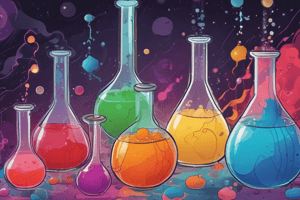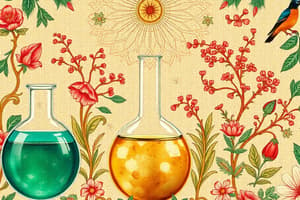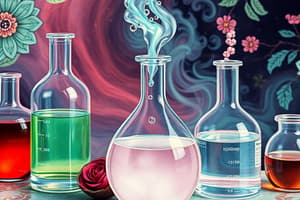Podcast
Questions and Answers
What type of chemical reaction involves two or more substances combining to form a single product?
What type of chemical reaction involves two or more substances combining to form a single product?
- Single Replacement
- Decomposition
- Synthesis (correct)
- Double Replacement
Which of the following describes an anion?
Which of the following describes an anion?
- An ion with both positive and negative charges
- A negatively charged ion that has gained electrons (correct)
- A neutral atom with no charge
- A positively charged ion that has lost electrons
What happens during a neutralization reaction?
What happens during a neutralization reaction?
- Two bases combine to form carbon dioxide
- An acid and a base produce hydrogen gas
- Two acids combine to form water
- An acid and a base produce a salt and water (correct)
Which of the following is NOT a characteristic of chemical transformations?
Which of the following is NOT a characteristic of chemical transformations?
Which of the following describes the pH scale?
Which of the following describes the pH scale?
In what situation would you observe gas production as an indicator of a chemical reaction?
In what situation would you observe gas production as an indicator of a chemical reaction?
What is the purpose of indicators in a solution?
What is the purpose of indicators in a solution?
Which statement accurately describes the conservation of mass during a chemical reaction?
Which statement accurately describes the conservation of mass during a chemical reaction?
Flashcards
Chemical Transformations
Chemical Transformations
Processes that change the composition of substances by breaking and forming bonds between atoms.
Types of Chemical Reactions
Types of Chemical Reactions
Synthesis, decomposition, single replacement, double replacement, and combustion are types of reactions.
Synthesis Reaction
Synthesis Reaction
A reaction where two or more reactants combine to form a single product.
Decomposition Reaction
Decomposition Reaction
Signup and view all the flashcards
Acids
Acids
Signup and view all the flashcards
Bases
Bases
Signup and view all the flashcards
pH Scale
pH Scale
Signup and view all the flashcards
Neutralization Reactions
Neutralization Reactions
Signup and view all the flashcards
Study Notes
Physical Sciences: Chemical Transformations, Ions, and pH (3rd Grade Level)
- Chemical Transformations: Processes that change the composition of substances.
- Involve breaking and forming bonds between atoms.
- Examples include combustion, reactions with acids, and rusting.
- Often accompanied by observable changes such as color change, gas production, or heat release or absorption.
Classifying Chemical Reactions
- Synthesis: Two or more reactants combine to form a single product.
- Decomposition: A single reactant breaks down into two or more products.
- Single Replacement: An element takes the place of another element in a compound.
- Double Replacement: The positive and negative ions of two compounds switch places.
- Combustion: A rapid reaction with oxygen, often producing heat and light.
Acids and Bases
- Acids: Substances that release hydrogen ions (H+) when dissolved in water.
- Bases: Substances that release hydroxide ions (OH-) when dissolved in water.
- pH Scale: Measures the acidity or basicity of a solution.
- Ranges from 0 to 14, with 7 being neutral.
- Values below 7 indicate acidity.
- Values above 7 indicate basicity.
Ions
- Ions: Charged particles formed from atoms.
- Cations: Positively charged ions (lost electrons).
- Anions: Negatively charged ions (gained electrons).
- Ionic compounds are formed by the electrostatic attraction between oppositely charged ions.
Acids, Bases, and Salts
- Neutralization Reactions: Reactions between an acid and a base that produce a salt and water.
- Formation of salts from acids and bases.
- Salt may not always be solid; it's also an ionic compound, but not necessarily a precipitate.
Important Chemical Concepts and Processes
- Conservation of Mass: Mass is neither created nor destroyed in a chemical reaction. The sum of the masses of the reactants equals the sum of the masses of the products.
- Balancing Chemical Equations: Using coefficients to ensure the conservation of mass in a chemical equation, ensuring each element appears the same number on each side.
- Indicators: Substances that change color depending on the pH of the solution. Litmus paper is an example.
Identifying Chemical Reactions
- Color changes
- Formation of a precipitate (solid)
- Production of gas (bubbles)
- Temperature changes (heat released or absorbed)
pH and Everyday Applications
- Importance of pH in living organisms and daily processes.
- pH in digestion and biological systems.
- pH of common solutions (e.g., lemon juice, soap, battery acid).
- Applying knowledge of acids and bases in various scenarios and solutions.
Recognizing Ions in Compounds
- Ions are involved in chemical reactions.
- Identifying common ions and their charges (e.g., Na+, Cl-, Ca2+, SO42-).
- Understanding the role of ions in ionic compounds.
Electrolytes
- Substances that produce ions when dissolved in water.
- Electrolytes conduct electricity.
- Explains why some liquids conduct electricity but others do not.
Chemical Concentrations/Molarity
- Molarity is a measure of the concentration.
- Explains the composition of solutions.
- Describes the number of moles of solute in one litre of solution.
Studying That Suits You
Use AI to generate personalized quizzes and flashcards to suit your learning preferences.




